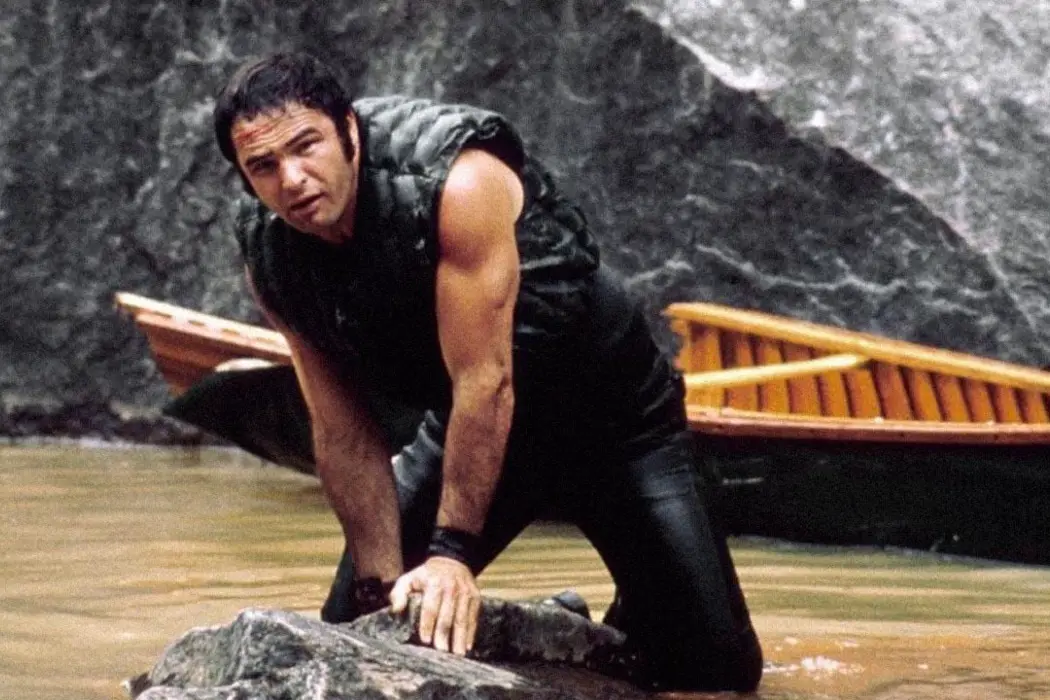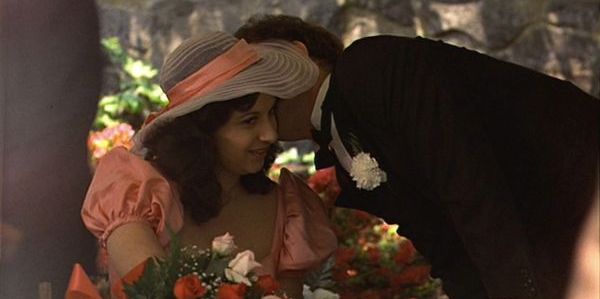Going To The Mattresses: How New Hollywood Wrestled With Sex, Success And Adaptation

Payton McCarty-Simas is a freelance writer and artist based in…
In the 1970s, a decade many have argued was the best time for cinema, film adaptations of bestselling novels were more common. It’s unsurprising then that several of the young, talented up-and-coming filmmakers of New Hollywood (many of whom have become the elder statesmen of Hollywood today) were taking on adaptations of paperback bestsellers themselves. Two of the most famous are Francis Ford Coppola‘s The Godfather (1972) and Stephen Spielberg‘s Jaws (1975). Both films were runaway successes, both the top grossing movies of the years in which they were released and remain classics to this day – and neither of them includes a large part of what the novels from which they were adapted banked on for their appeal: sex. And lots of it.
The reasons for the omission of sex in these two films paint a fascinating portrait of a tumultuous period in Hollywood history when New Hollywood brought new life and energy–– and sexuality–– to the film industry. Hollywood cinema and sexuality have a long and complicated history, but this period, in particular, proved to be an inflection point where sex was more permitted, but only to a point. With the demise of The Hays Code in 1968 – a series of guidelines championed by religious groups like the Catholic Legion of Decency geared towards maintaining “morality” in the film–– films were in some ways becoming more openly raunchy. Because they didn’t have to fear the financial disaster a “C” (“condemned”) rating would cause as they did in the 1950s (when “condemned” films would be pulled from theaters) sex was seen as a selling point for mainstream films in addition to exploitation, the more traditional arena for sexual explicitness. Films like Baby Doll (1956) began breaking this mold prior to the end of the Code, when, in a first, despite its C rating, it did well both critically and financially and garnered four Academy Awards. By 1972, just four years after guidance against “prolonged kissing” and “lustful embraces” explicitly banned “scenes of passion” in the Hays Code, the unprecedented smash success of the X-rated Last Tango in Paris (1972) and the hardcore pornographic film Deep Throat (1972) began a period of “porno chic” in which open discussions of explicit sexuality onscreen were viewed as progressive, glamorous, and mature rather than vulgar.
In light of this more permissive atmosphere, the differing trajectories which led to the de-sexualization of the stories of The Godfather and Jaws novels, in conversation with the increased emphasis on sexual explicitness in John Boorman‘s cult classic adaptation of the novel Deliverance, point to film studio’s contradictory impulses when faced with sexual material at the time, torn between differing financial incentives.
“That Pole of Sonny’s”
In The Godfather, Sonny, beautifully played in the film by the late James Caan, was supposed to be defined not just by his hot-headedness… but, to put it mildly, by his “massive organ.” So massive in fact, that the degrees to which Mario Puzo goes to characterize his “blood-gorged pole of muscle” border on all-out threatening: his “martyred” wife, for example, is described as “fearing the marriage bed as unbelievers once feared the rack,” and tells her friends in an anecdote that begs more than one medical exam.
There is in fact an entire subplot of Puzo‘s novel entirely dedicated not only to the tremendousness of Sonny’s member but to the requisite enormity of his love interest’s vagina. In short, they’re perfect for each other. Even after Sonny’s death at the hands of a rival Family, the subplot inexplicably continues, completely divorced from the Mob War at hand, and becomes even more literally gynecological in nature: Sonny’s bereft lover, Lucy Mancini (Jeannie Linero in the film) whose second lover “mumbled something about her being ‘too big down there” after they slept together for the first time, eventually finds love with a Las Vegas doctor who realizes her “problem” is a weak pelvic floor. He fixes her up with a surgeon friend of his who, as her new lover watches, “[builds her] a new snatch as easily as a carpenter nails together two-by-four studs,” making it extra tight for his friend who watches the surgery in what is absolutely a violation of her bodily autonomy reminiscent of Carmen Maria Machado‘s “The Husband Stitch.”

The reason for this subplot’s existence in the novel is clear from Puzo‘s history as laid out in books and oral histories of Coppola‘s film. According to Mark Seal‘s book, Leave the Gun, Take the Cannoli, before The Godfather, Puzo had written two novels, both of which failed to sell. With a large family and a severe gambling addiction, Puzo eventually went to work for a company dedicated to “men’s magazines” with names like For Men Only and Male, churning out pornographic pulp fiction such as “The Battle Angels: Broads-and-Booze GI Hell-Cyclists Who Smashed Hitler’s Panzer Army” as fast as he could. Faced with crushing debt and no prospects, Puzo‘s son Christopher later said, “My father knew… there was a formula for writing a bestselling book” and he was determined to write one. The formula? “Over-the-top memorable characters; multiple plot lines; and some sex” Thus, Lucy Mancini’s voluble anatomical troubles were born, in addition to another subplot cut from the film following the (highly sexual) adventures of a thinly disguised Frank Sinatra stand-in, an aging crooner named Johnny Fontaine who so offended Sinatra himself he threatened to sue and made Puzo cry when they met by chance in Las Vegas.
Seal also points out that Puzo‘s understanding of sex’s commercial appeal expressly translated over to his screenplay: “He wanted to make sure the people got what they wanted, and he spelled it out in the very first line of his notes: ‘Sex Scenes’ it reads… ‘Too long a stretch without sex,’ he scrawled at one point. ‘Enlarge sex scene,’ he noted in another.” Even then, Paramount encouraged Puzo to include even more sex and cut down on anything he could to cut costs. The emphasis on sex was great enough that Paramount insisted he begins the entire script with a sex scene between Michael and Kay against the author’s protestations.
While Paramount had been one of the “Big Five” studios of Hollywood’s Golden Era, by the 1960s they were in serious decline, forcing them to cut back on production and release many of their stars from their contracts. Because of this dire financial situation, the executives at Paramount, like Puzo during his many years of near-destitution, turned to pulp sexuality as an obvious commercial draw for a film they believed would not otherwise succeed. Puzo and director Francis Ford Coppola (who wrote the screenplay together) both protested. Iconic producer Robert Evans backed up Puzo and Coppola, and thus was able to limit what all three viewed as gratuitous sex scenes to add to the air of prestige and seriousness they were already cultivating with careful lighting, mise-en-scene, and script revisions. In so doing, they produced one of the greatest films of all time and re-established Paramount as a major studio. That’s not to say there’s no sex in The Godfather (the first sex scene between Sonny and Lucy is even included, and much time is spent ogling Michael’s underage Sicilian bride on their wedding night). That said, it’s hard to imagine The Godfather‘s soaring tale of family, violence, and the American Dream having the same impact if any of its runtimes was dedicated to such riveting material as someone’s “voracious plummet onto [someone else’s] sexual organ without even a courteous and friendly word of preparation.” As it stands, the film was an indescribable success. AFI has called it the third greatest film of all time, and it takes the first spot in the minds of many.
“Thinking of Pudenda”
The story of Jaws is similarly neutered in its adaptation, though due to contrasting commercial strategies. In Peter Bencheley‘s novel, Jaws, sex comes up almost constantly: Chief Brody (Roy Scheider in the film) is actually introduced having a dream “that he was back in high school groping a girl in a stairwell;” Teenage boys seemingly just lying on beach towels are, mindbogglingly, described as “enjoying the sensation of grinding their pelvises in the sand, thinking of pudenda.” Similarly, an unreasonable amount of time is dedicated to Matt Hooper, the young marine biologist played by Richard Dreyfuss in the film, seducing Chief Brody’s wife, Ellen (Lorraine Gary). Indeed, he spends a lot of time impressing Chief Brody’s wife with his knowledge of tennis in addition to sharks, his table manners, tales of his rich family–– and, finally, sleeping with Chief Brody’s wife. Benchley‘s writing, full of choice phrases about Ellen like “her feet were perfect enough to suit any pedophile” is just as smutty as Puzo‘s sex scenes and is obviously meant to add spice to a bestselling paperback of the beach-read variety, but it’s also a significant thematic element in the novel’s class allegory and its cutting is indicative of the depoliticization of the story.
While Paramount’s need for a big box office success drew them to the sexuality of Puzo‘s novel, Universal Pictures, another Big Five studio hit hard by the death of the studio system, took a different tact. Whereas Paramount struggled to adjust to the shifting film landscape of the 1960s, Universal was able to adapt by shifting tacts and focusing heavily on television production, eventually merging its TV and film branches. As such, rather than using sex appeal as a studio attempting to take advantage of the new lack of film censorship in theaters would, Universal sanitized the story for television and made the film less thematic and more commercial than the novel upon which it was based. Jaws producer Richard Zanuck told Benchley, who also co-wrote the screenplay, “this picture is going to be an A-to-Z adventure story, a straight line, so we want you to take out all the romance stuff… all the stuff that’ll just be distracting”.
Unlike Puzo, Benchley fought to keep his sex scenes in for the sake of their thematic merit. The novel’s town of Amity is one full of uneasy political alliances, corruption, and barely concealed violence. The shark is depicted as a sort of demon, “God’s will… punishing [the town] for its sins” from accepting graft to concealing corruption and rape in the press (the town was also named for a “seventeenth-century woman… who has been convicted of witchcraft” adding to the feeling of divine wrath). Class tensions are high and the barriers they create between characters take up most of the novel’s length. As such, Chief Brody, who is a lifelong blue-collar Long Islander in the novel rather than a middle class New York City transplant as in the film, struggles with feelings of inferiority because his wife was originally one of the wealthy “summer people.” Thus, the problems in their relationship are played out through her affair with Hooper in a narrative mirror to the “parasitic” way the town both relies on and reviles its wealthy vacationers to survive. According to Screenrant, Spielberg rejected three drafts of Benchley‘s script for Jaws that included these details and told actors not to read the book at all. Eventually, when Benchley continued to protest the changes, he was kicked off set.
Regardless of the motivations behind them, the cuts made to the narratives of these two classic films were obviously the right choices in retrospect. They also depict a moment in time when Hollywood’s identity was shifting radically, torn between a recent loosening of regulations on sexuality and the newly booming television market with its own emphasis on clean, family friendly content. Jaws, in addition to Star Wars two years later, would prove to be the hinge between the more political (or “high concept” as Richard Zanuch, the Jaws producer derisively called them) blockbusters of the 1970s and the enormous action blockbusters of the 1980s. The inclusion of the sex farce subplot in The Godfather would have brought the film closer to porn films like Deep Throat released the same year. Conversely, keeping the class allegory and sexual subplot in Jaws would complicate the narrative and bring it closer to political thrillers like another contemporaneous classic Chinatown (1974), demonstrating the ways in which trends impact the level of sexuality on display in films with a high level of commercial incentive just a few years apart.
“Squeal Like a Pig!”
Not all classic 1970s film adaptations chose to cut or downplay the sexual elements of the novels from which they were adapted, however. John Boorman‘s Deliverance (1972), adapted from poet laureate James Dickey‘s novel of the same name, remains infamous today. It managed to straddle the line of TV respectability while also striking controversy with its content by actually playing up the sexual elements of the novel, making them both more explicit and more brutal. The most famous scene in the film, a man-vs-wild story about Southern city boys trying to rough it during a canoe trip gone awry, is a gruesome rape of one of the main characters by a “mountain man” with a shotgun. Infamously, the rapist berates his victim to “squeal like a pig,” literally forcing him to make pig sounds as he is violated.
Beyond perpetuating classist and homophobic stereotypes about the South that caused an uproar upon the film’s release, the scene was actually made more disturbing for the film than in the novel. The scene, shot almost entirely in one continuous and nerve-shattering single take, seemingly stretches forever. The shooting went on for so long that Burt Reynolds reportedly ran in front of the camera to stop the take. The harrowing line “squeal like a pig” that haunted actor Ned Beatty for years as strangers would yell it at him on the street, does not appear in any version of the script or the novel. In the novel, the scene, though still central, takes a little over two pages with any explicit details confined to a few sentences. Boorman claims that the line was chosen in lieu of shooting two versions of the scene, one for television and one for theatrical release. Paradoxically, this cruel and debasing line that renders an already skin-crawling scene legendarily disturbing, served as a “clean” alternative acceptable for both media. In so doing, contrary to the strategy employed by Jaws just three years later, Deliverance demonstrates that even within the new world of mass television viewership there was flexibility in defining what level of sexuality was acceptable–– and the limits were at times surprisingly extreme. Like Benchley on Jaws, Dickey was ejected from the set–– less for the obvious creative differences (he reportedly screamed “God, they’re ruining my f***ing movie, ain’t they? They’re not doing my book!”) and primarily for his famous drunken, erratic behavior (he attacked Boorman and broke his nose after this outburst).
Conclusion
“Why don’t the authors of original books write original screenplays?” author James Michener asked when he presented Chinatown with the Academy Award for Best Original Screenplay in 1975. “The sad fact is that most of us do not have the talent for the concise and demanding art form” that is screenwriting. And yet, the delicate, often deeply contentious symbiotic interplay between the novelists and the teams who turn their bestsellers into blockbusters, particularly in the 1970s, paints a fascinating portrait of Hollywood undergoing a radical transition. Questions of censorship and sex on screen have come back to the fore in recent years, with sexuality often viewed as a box office drawback for a globalized market. Understanding the complex and often contradictory factors behind the creation of classic films like The Godfather and Jaws in addition to infamous horror films like Deliverance, also illuminates the ways in which the financial incentives of the media landscape in a particular era shape our cultural touchstones today.
What do you think? Let us know in the comments!
Does content like this matter to you?
Become a Member and support film journalism. Unlock access to all of Film Inquiry`s great articles. Join a community of like-minded readers who are passionate about cinema - get access to our private members Network, give back to independent filmmakers, and more.
Payton McCarty-Simas is a freelance writer and artist based in New York City. They grew up in Massachusetts devouring Stephen King novels, Edgar Allan Poe stories, and Scooby Doo on VHS. Payton holds a masters degree in film and media studies from Columbia University and her work focuses on horror film, psychedelia, and the occult in particular. Their first book, One Step Short of Crazy: National Treasure and the Landscape of American Conspiracy Culture, is due for release in November.












